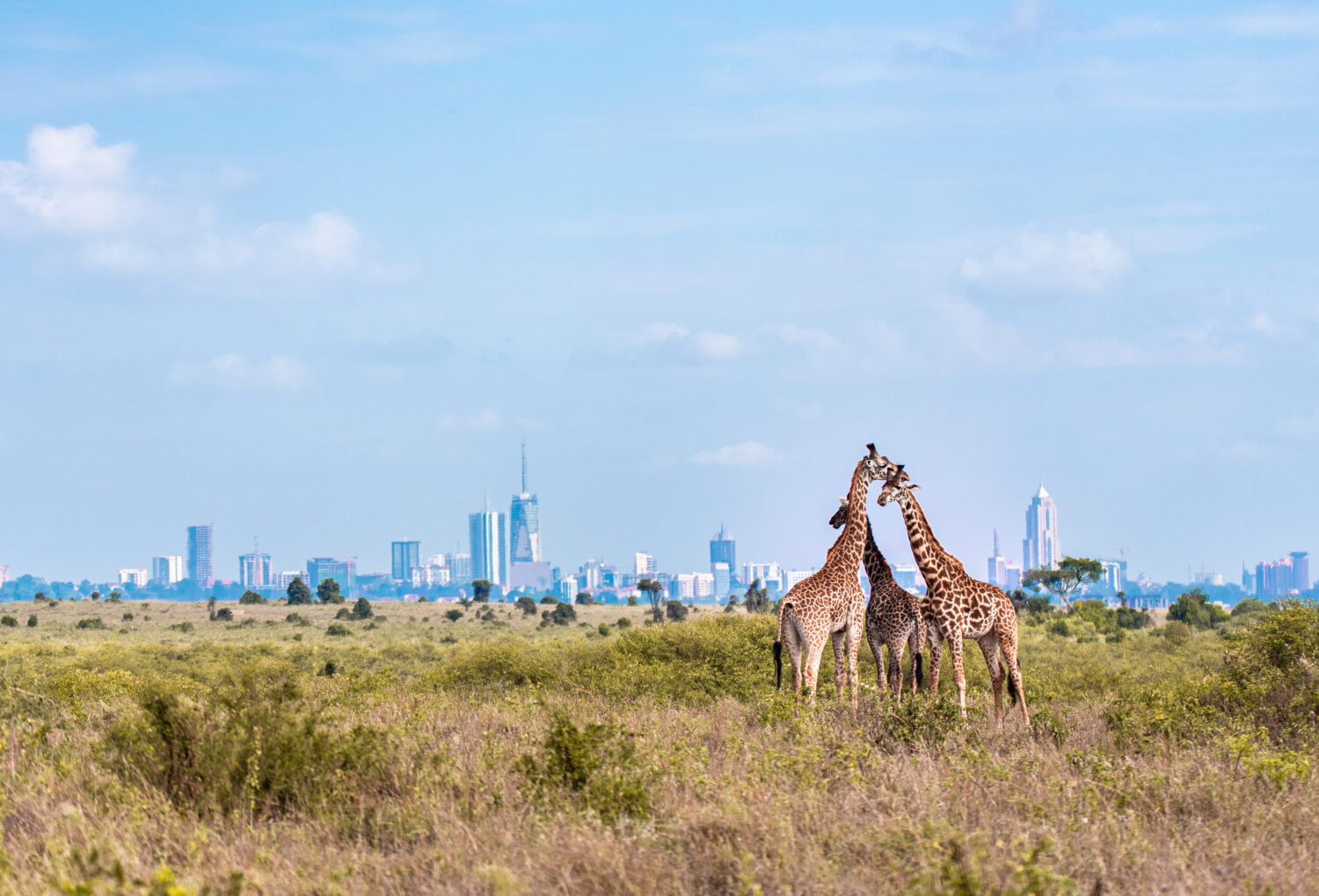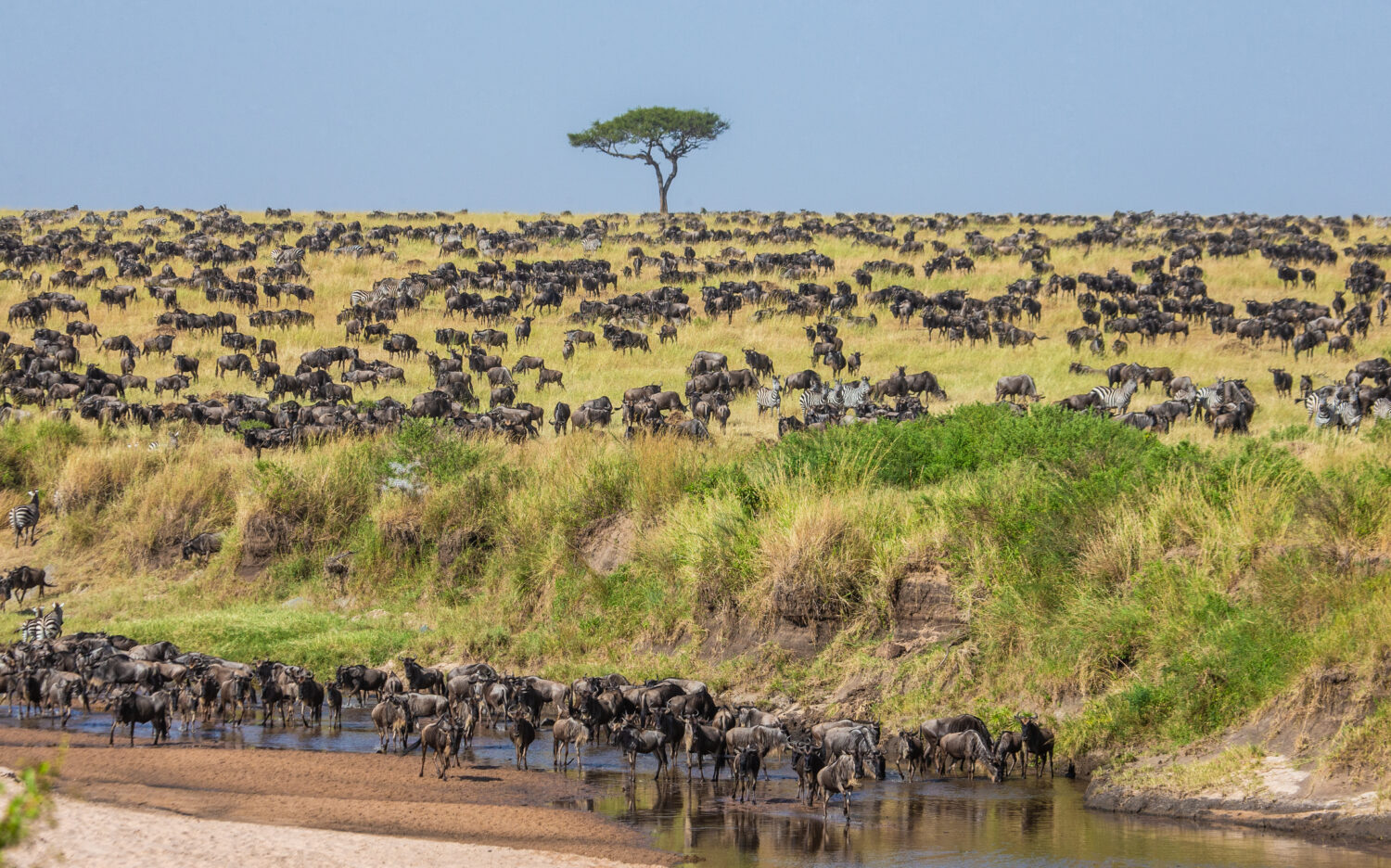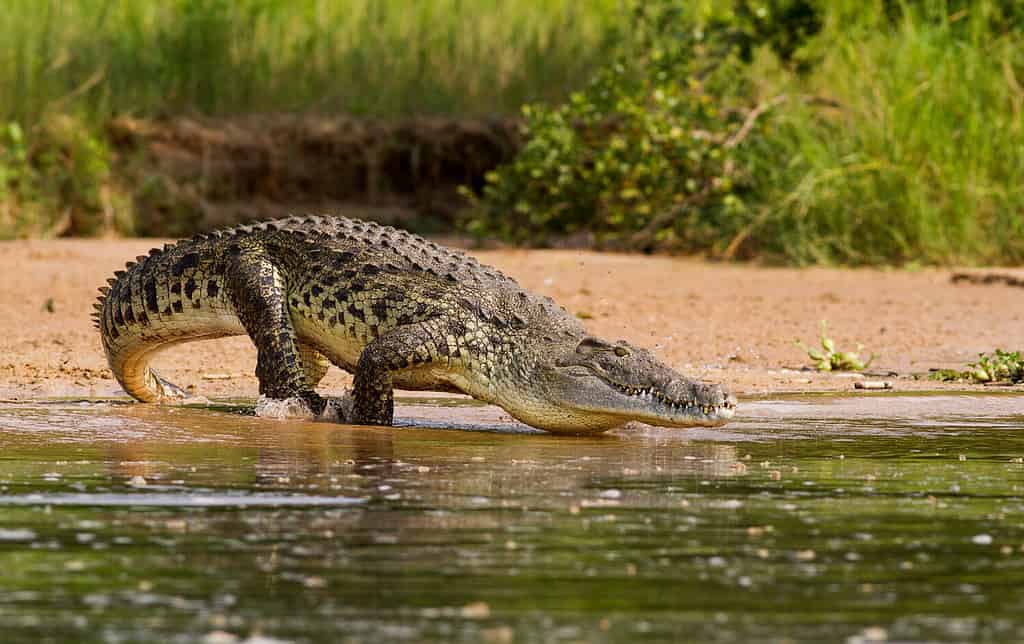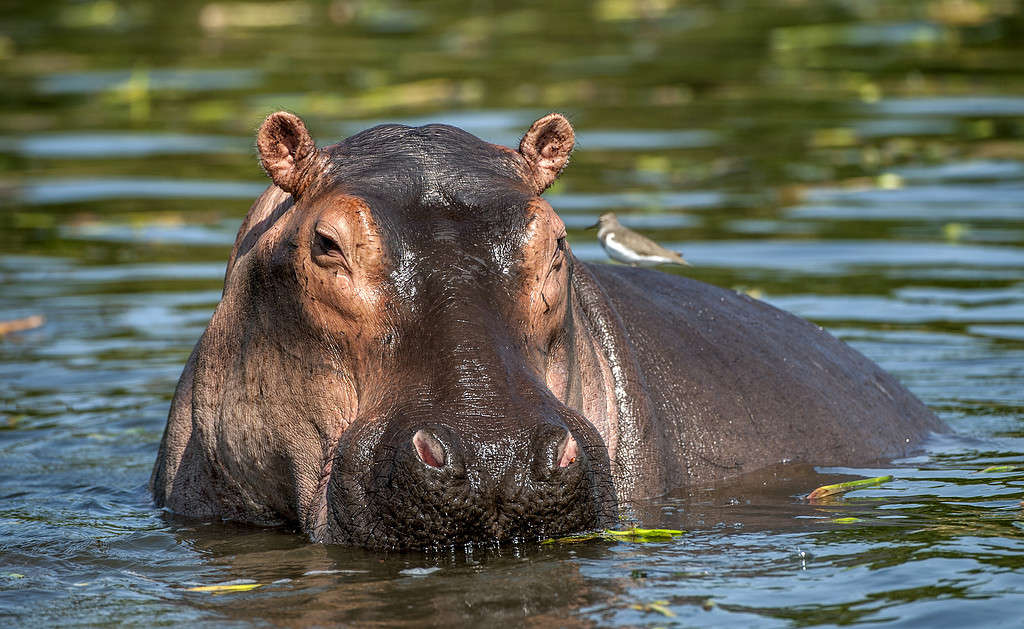Discover the 3 African Countries Bordering Lake Victoria
Bwindi Impenetrable National Park
The national park is home to half the world’s endangered mountain gorillas. It offers gorilla trekking experiences where visitors can observe these magnificent creatures up close. Additionally, the park is also home to other primate species like chimpanzees.
Queen Elizabeth National Park
With its diverse ecosystems, the park is home to the famous tree-climbing lions of Ishasha. Boat safaris on the Kazinga Channel are available to observe spot hippos, crocodiles, and various birds.
Murchison Falls National Park
This park features the stunning Murchison Falls, where the Nile River is forced through a narrow gorge, creating a stunning landscape. In addition, visitors can see elephants, giraffes, and buffaloes.
Mgahinga Gorilla National Park
As a UNESCO World Heritage site, the park is part of the Virunga Mountains and is home to mountain gorillas and golden monkeys. It offers gorilla trekking and golden monkey tracking experiences.
Rwenzori Mountains National Park
Also called the “Mountains of the Moon,” these mountains feature snow-capped peaks, glaciers, and alpine meadows. It offers excellent opportunities in hiking and mountaineering but requires a little experience.
Semuliki National Park
This park has unique flora and fauna, including the renowned Sempaya Hot Springs. Visitors can also enjoy the presence of various primate species, including chimpanzees and baboons.
Lake Mburo National Park
Another excellent destination for safaris is Lake Mburo National Park. It is home to zebras, impalas, and various antelopes. With its stunning acacia woodlands, the park offers wildlife-watching drives as well as boat and horseback safaris.
Kidepo Valley National Park
If you want to escape the crowds, head to Kidepo Valley National Park, located in northeastern Uganda. Visitors will be able to observe lions, cheetahs, and elephants.
Kenya

©Karan Khalsa/Shutterstock.com
Between Tanzania, Uganda, and Kenya, the latter — Kenya — has the least lake area in its territory. It only encompasses 6% of the lake, with 1,600 square miles (4,100 square kilometers).
Lake Victoria forms a natural border to the west of Kenya but also serves as a crucial water source, a hub for fishing and transportation for Kenyan communities living along the lake.
The country covers 224,081 square miles (580,367 square kilometers). Kenya borders to the north Ethiopia and South Sudan. To the west, it borders Uganda, and to the south, Tanzania. Finally, to the east, Kenya shares a border with the Indian Ocean and Somalia.
Kenya has over 51 million people in 2023, with many ethnic groups and tribes officially speaking Swahili, English, and 66 other languages. The country’s history is blended between indigenous traditions, the influences of Arab traders, Portuguese explorers, and British colonial rule. Kenya gained its independence in 1963 from the British.
Like its history, Kenyan culture is a mix of traditions and practices. The Maasai, Kikuyu, Luo, Luhya, and many others bring their unique customs, music, dance, and art to the national identity.
Things to See in Kenya

©GUDKOV ANDREY/Shutterstock.com
Like Tanzania, Kenya is most famous for its stunning national parks and wildlife reserves. Here are some of Kenya’s most famous national parks.
Maasai Mara National Reserve
Located in southwestern Kenya, the Maasai Mara is one of the most famous wildlife destinations in the world. It is renowned for its annual wildebeest migration that attracts thousands of tourists. Millions of wildebeest, zebras, and other herbivores cross the Mara River in search of greener pastures. The park is also home to the “Big Five.”
Amboseli National Park
Situated in the shadow of Mount Kilimanjaro, Amboseli is famous for its stunning vistas of Africa’s highest peak. It offers excellent wildlife viewing of elephant herds with the peak as the backdrop.
Tsavo National Park
Tsavo is one of Kenya’s largest national parks. It is divided into Tsavo East and Tsavo West. Tsavo is home to various wildlife in its savannahs and volcanic hills, including lions, leopards, rhinoceroses, and elephants.
Samburu National Reserve
In northern Kenya, Samburu is an excellent destination to see unique and rare wildlife. The park is home to the Grevy’s zebra, reticulated giraffe (native to the Horn of Africa), and Somali ostrich.
Lake Nakuru National Park
This park surrounds Lake Nakuru, famous for its extensive pink flamingo population. Visitors can also observe rhinos, lions, and various bird species.
Nairobi National Park
Close to Kenya’s capital city, Nairobi National Park offers a unique opportunity for locals and visitors to see wildlife while close to the town. Visitors can spot lions, giraffes, zebras, and various antelope species.
Aberdare National Park
In central Kenya, visitors to the Aberdare Mountains and the national park may see elephants, buffaloes, leopards, and rare animals like the bongo and giant forest hog.
Mount Kenya National Park
This park, also a UNESCO World Heritage, is home to Mount Kenya, Africa’s second-highest peak. The park offers trekking and climbing opportunities where visitors can spot diverse wildlife and unique flora.
What Wildlife Can You See at Lake Victoria?

©diegooscar01/Shutterstock.com
With its extensive size and large range of ecosystems, Lake Victoria is home to many wildlife species. These live within the lake and its surrounding wetlands, forests, and savannahs.
However, multiple factors threaten the lake’s wildlife. These include habitat loss, pollution, and overfishing. Invasive species like the Nile perch had significant ecological impacts, especially on smaller fish. Conservation efforts are ongoing to help preserve and protect Lake Victoria’s wildlife.
Reptiles
Lake Victoria is home to some of the most dangerous reptiles in the world. One of them is the feared Nile crocodile. This species can reach from 16 to 20 feet (approximately 5 to 6 meters) in length, depending on the adults. Nile crocodiles have a bite force of 5,000 PSI (pounds per square inch), the second strongest in the world behind saltwater crocodiles.
They mainly eat fish but will attack large prey like zebras, antelopes, small hippopotamuses, and even other crocodiles. When they don’t hunt for fish, they hide and wait until the prey comes to drink water from the lake. Plus, Nile crocodiles also attack and eat humans. They are considered the most dangerous crocodilian globally, with an estimated 300 yearly attacks (sometimes up to 700!) Over 60% of these attacks are deadly.
Lake Victoria is home to the African softshell turtle, commonly found in the wetlands and slow-moving waters around the lake. This species has a unique soft and rubbery shell and is adapted to an aquatic lifestyle. The lake is also home to terrapins adapted to terrestrial and aquatic lifestyles. They live in the wetlands and shallower waters and are often seen basking on logs or rocks.
Lake Victoria and its surroundings are also home to various species of lizards. Both the monitor and the agama lizards live in the area. The monitor lives in the forests and wetlands around the lake, often basking in the sun and hunting for insects and small animals. They have long tails, sharp claws, and keen predatory instincts. The agama prefers rocky and sandy areas. During the breeding season, they display vibrant hues on their bodies.
A few snakes live around the lake, the African rock python and some colubrid snakes. However, they are elusive and hard to spot.
Mammals

©iStock.com/Sergei Uriadnikov
Lake Victoria is home to various mammals. Especially a feared one that inhabits its waters, the hippopotamus. A male hippopotamus weighs 3,500 to 9,920 pounds (1,588 to 4,500 kilograms). Length-wise, they are between 11 and 17 feet (3.4 to 5.2 meters). Height-wise, they can be up to 5.2 feet (1.58 meters) tall at their shoulder.
Hippopotamuses have the strongest bite force of all land animals, with 1820 PSI (pounds per square inch). However, this species is primarily herbivorous, eating approximately 80 pounds (36.3 kilograms) of grass daily. Scientists have observed this species occasionally feed on animal carcasses in recent years.
Hippos are very territorial on their territory, especially in the water. It is not uncommon to see hippos charging boats in a defense response. They move fast in the water, and on land, they can outpace a human by running up to 20 mp/h (32.2 km/h), while a human averages between 6 to 8 mph (9.6 to 12.9 km/h). Hippos are one of the deadliest animals in Africa, killing over 500 people a year.
Outside of hippos, Lake Victorias is home to various smaller mammal species. These include otters and multiple antelope species in the wetlands and forests bordering the lake. Primates like vervet monkeys and baboons live in the neighboring forests.
Aquatic Species
Numerous fish species inhabit Lake Victoria’s waters. The most famous are the Nile perch and the tilapia. They play a significant role in the lake’s ecosystem as they are a favorite prey for several birds and reptiles. Plus, you probably already saw these names in your local supermarkets. Both are some of the world’s cheapest and most consumed fish species. In Lake Victoria, they are vital for the well-being of the fishing industry. Lake Victoria is also home to various small fish, most of which are endemic.
In addition to the fish, the lake hosts an array of aquatic plants. These include water lilies, papyrus reeds, and others. They provide habitat and food for various fish and bird species.
Birds
For bird enthusiasts, Lake Victoria and its surrounding wetland are a paradise. Various bird species live there, including African fish eagles, kingfishers, herons, cormorants, pelicans, and more. Lake Victoria is also an important breeding and feeding ground for numerous migratory birds.
Insects and Invertebrates
Lake Victoria’s region teems with insect life, including butterflies, dragonflies, and various aquatic insects. Insects especially thrive in the wetland areas.









